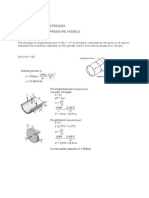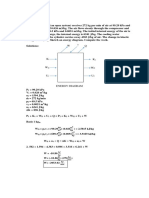0 ratings0% found this document useful (0 votes)
570 viewsMEC2213 Shearing Tutorial
The document describes a 60m tall rectangular building that is subjected to wind loads. The building face is divided into three layers and wind pressure values are given for each layer: 781 N/m2 for the lower layer, 1264 N/m2 for the middle layer, and 1530 N/m2 for the top layer. The document asks to determine the resisting shear that the foundation must develop to withstand the wind load on the building.
Uploaded by
Alex CheeCopyright
© Attribution Non-Commercial (BY-NC)
Available Formats
Download as PDF, TXT or read online on Scribd
0 ratings0% found this document useful (0 votes)
570 viewsMEC2213 Shearing Tutorial
The document describes a 60m tall rectangular building that is subjected to wind loads. The building face is divided into three layers and wind pressure values are given for each layer: 781 N/m2 for the lower layer, 1264 N/m2 for the middle layer, and 1530 N/m2 for the top layer. The document asks to determine the resisting shear that the foundation must develop to withstand the wind load on the building.
Uploaded by
Alex CheeCopyright
© Attribution Non-Commercial (BY-NC)
Available Formats
Download as PDF, TXT or read online on Scribd
You are on page 1/ 8
TUTORIAL
A building that is 60 m tall has essentially the rectangular conguration shown in Figure.
! !
Horizontal wind loads will act on the building exerting pressures on the vertical face that may be approximated as uniform within each of the three "layers" as shown.
From empirical expressions for wind pressures at the midpoint of each of the three layers, we have a pressure of 781 N/m2 on the lower layer, 1264 N/m2 on the middle layer, and 1530 N/m2 on the top layer.
Determine the resisting shear that the foundation must develop to withstand this wind load.
Side View
TUTORIAL
You might also like
- Question: A Cube 2.2 FT On An Edge Has Its Lower Half of S 1.6 and UpperNo ratings yetQuestion: A Cube 2.2 FT On An Edge Has Its Lower Half of S 1.6 and Upper1 page
- Take Home Exam 19 Engineering Mechanics 02 and 03 SolutionNo ratings yetTake Home Exam 19 Engineering Mechanics 02 and 03 Solution11 pages
- Module 2.4 Enthalpy and 2ND Corollary of 1ST LawNo ratings yetModule 2.4 Enthalpy and 2ND Corollary of 1ST Law6 pages
- Garcia, Jonalie M. ACTIVITY ON PYRAMIDS (PART 10)No ratings yetGarcia, Jonalie M. ACTIVITY ON PYRAMIDS (PART 10)4 pages
- Thermodynamics Super Ultra Mega Practice ProblemNo ratings yetThermodynamics Super Ultra Mega Practice Problem133 pages
- BES 026 Dynamics of Rigid Bodies COMPLETEDNo ratings yetBES 026 Dynamics of Rigid Bodies COMPLETED165 pages
- A Reheat Cycle With Two Stage of Reheating Is Executed With Steam Expanding Initially From 90 Bar and 530c The Two Reheater Pressure Are 10 Bar50% (4)A Reheat Cycle With Two Stage of Reheating Is Executed With Steam Expanding Initially From 90 Bar and 530c The Two Reheater Pressure Are 10 Bar1 page
- Descriptive Title: Department of Mechanical EngineeringNo ratings yetDescriptive Title: Department of Mechanical Engineering50 pages
- Fluid Statics: Principles of Hydrostatics Pressure or Unit Pressure, PNo ratings yetFluid Statics: Principles of Hydrostatics Pressure or Unit Pressure, P11 pages
- Thermodynamics 1 Practice Problems - Chapter 2No ratings yetThermodynamics 1 Practice Problems - Chapter 25 pages
- Solution 304: Hide Click Here To Show or Hide The Solution100% (1)Solution 304: Hide Click Here To Show or Hide The Solution21 pages
- MODULE 1 - Introduction To Differential Equations100% (1)MODULE 1 - Introduction To Differential Equations10 pages
- Fluid Machine Problems - cavitation&NPSHNo ratings yetFluid Machine Problems - cavitation&NPSH3 pages
- The Equivalent Solution Is A Mathematical Technique Used in Vibration Engineering To Simplify The Analysis of Complex Vibrating SystemsNo ratings yetThe Equivalent Solution Is A Mathematical Technique Used in Vibration Engineering To Simplify The Analysis of Complex Vibrating Systems4 pages
- Wind Pressure Distribution On Trough Canopy Roofs: Pradeep Singh, Ashok K. AhujaNo ratings yetWind Pressure Distribution On Trough Canopy Roofs: Pradeep Singh, Ashok K. Ahuja4 pages
- Chapter 4: Forces Due To Static Fluids: EM 208: Fluid MechanicsNo ratings yetChapter 4: Forces Due To Static Fluids: EM 208: Fluid Mechanics6 pages
- Chapter 4: Forces Due To Static Fluids: EM 208: Fluid MechanicsNo ratings yetChapter 4: Forces Due To Static Fluids: EM 208: Fluid Mechanics6 pages
- NCWE 007 - Full Length Paper - A K Roy - IITR-finalNo ratings yetNCWE 007 - Full Length Paper - A K Roy - IITR-final9 pages
- DIY.a.gas Turbine - Engine.from - An.autornobile - Turbocharger.rules - Of.thumbNo ratings yetDIY.a.gas Turbine - Engine.from - An.autornobile - Turbocharger.rules - Of.thumb36 pages
- MEC 2213 Engineering Solid Mechanics: Chapter:! Shearing Force IINo ratings yetMEC 2213 Engineering Solid Mechanics: Chapter:! Shearing Force II10 pages
- Question: A Cube 2.2 FT On An Edge Has Its Lower Half of S 1.6 and UpperQuestion: A Cube 2.2 FT On An Edge Has Its Lower Half of S 1.6 and Upper
- Take Home Exam 19 Engineering Mechanics 02 and 03 SolutionTake Home Exam 19 Engineering Mechanics 02 and 03 Solution
- A Reheat Cycle With Two Stage of Reheating Is Executed With Steam Expanding Initially From 90 Bar and 530c The Two Reheater Pressure Are 10 BarA Reheat Cycle With Two Stage of Reheating Is Executed With Steam Expanding Initially From 90 Bar and 530c The Two Reheater Pressure Are 10 Bar
- Descriptive Title: Department of Mechanical EngineeringDescriptive Title: Department of Mechanical Engineering
- Fluid Statics: Principles of Hydrostatics Pressure or Unit Pressure, PFluid Statics: Principles of Hydrostatics Pressure or Unit Pressure, P
- Solution 304: Hide Click Here To Show or Hide The SolutionSolution 304: Hide Click Here To Show or Hide The Solution
- The Equivalent Solution Is A Mathematical Technique Used in Vibration Engineering To Simplify The Analysis of Complex Vibrating SystemsThe Equivalent Solution Is A Mathematical Technique Used in Vibration Engineering To Simplify The Analysis of Complex Vibrating Systems
- Wind Pressure Distribution On Trough Canopy Roofs: Pradeep Singh, Ashok K. AhujaWind Pressure Distribution On Trough Canopy Roofs: Pradeep Singh, Ashok K. Ahuja
- Chapter 4: Forces Due To Static Fluids: EM 208: Fluid MechanicsChapter 4: Forces Due To Static Fluids: EM 208: Fluid Mechanics
- Chapter 4: Forces Due To Static Fluids: EM 208: Fluid MechanicsChapter 4: Forces Due To Static Fluids: EM 208: Fluid Mechanics
- NCWE 007 - Full Length Paper - A K Roy - IITR-finalNCWE 007 - Full Length Paper - A K Roy - IITR-final
- DIY.a.gas Turbine - Engine.from - An.autornobile - Turbocharger.rules - Of.thumbDIY.a.gas Turbine - Engine.from - An.autornobile - Turbocharger.rules - Of.thumb
- MEC 2213 Engineering Solid Mechanics: Chapter:! Shearing Force IIMEC 2213 Engineering Solid Mechanics: Chapter:! Shearing Force II


































































